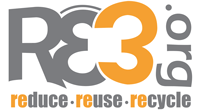 Guest Blogger - Kristen Aubut
Guest Blogger - Kristen AubutPhoto from British Columbia Ministry of the Environment
I was going down the cookware aisle at Target looking for a cutting board. I stopped in front of the display of cutting boards, and I began to read the labels on each one. I didn’t want just any old cutting board. I wanted a “sustainable” one. I wasn’t sure what a cutting board could do to be sustainable, but I figured the labels might tell me. There were wooden ones, glass ones, marble ones and plastic ones. I settled on a plastic one. This N.C. State red cutting board didn’t match my kitchen décor, but the label convinced me that this one fit my requirement of being sustainable. The label stated, “Eco Smart: Live Eco. Live Smart. 100% Recycled Food Grade Plastic. When finished with this product, please call toll free (800) 659-9786 to request a freight pre-paid shipping label.”
Perfect! This cutting board is made from recycled plastic and, when the surface gets too scarred for further use, I can send it back to the manufacturer to be melted down to make more cutting boards! That sounds sustainable to me. As an added bonus, this sustainable cutting board was no more expensive than the other “less sustainable” ones.
Without seeing it coming, this little red cutting board opened me up to the world of “product stewardship.” As this concept finds its way into grocery stores, department stores and big box stores, you’ll want to make sure you know all about it.
As the EPA explains, “product stewardship calls on those in the product life cycle- manufacturers, retailers, users and disposers- to share responsibility for reducing the environmental impacts of products.” In other words, manufacturers that adopt this philosophy design their products to require less material, to be made from recycled materials and to be more easily reused and recycled. Manufacturers take responsibility for their products from the cradle to the grave. According to the EPA, product stewardship not only leads to a reduction of waste, but it also has the potential to increase manufacturing productivity, reduce production costs, and increase competitive advantage.
My N.C. State red cutting board is just a small glimpse of the exciting things manufacturers and other entities are doing to incorporate product stewardship into their business plans. How about my Styrofoam egg carton from Harris Teeter that states on its label that, “If you want to recycle this carton we have some good news! You can mail the cartons to us anytime and we will make sure they get recycled. Please ship to Dolco Packaging.” How about the pharmaceutical mail-back pilot just completed by the University of Maine through which you can mail your unused medicines to be properly disposed of instead of allowing the medicines to end up in the landfill or waterway (Product Stewardship Institute). There are many more examples of product stewardship out there.
Remember, many products call themselves sustainable, eco-friendly or earth-friendly, but many of them don’t live up to the label. Take a moment to see what credentials the product actually has to make itself worthy of being labeled sustainable. If you find a product which can be sent back to the manufacturer at the end of its life, then that is considered a product worthy of the label “sustainable.”
Check out the Product Stewardship Institute website to find out more about this exciting concept. Visit http://www.productstewardship.us/.
Tell us what you think!
Do you have any products that can be sent back to the manufacturer at the end of its life?

No comments:
Post a Comment